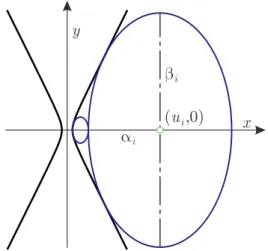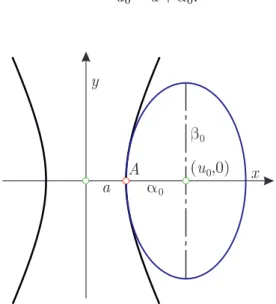Integer sequences and ellipse chains inside a hyperbola
Hacène Belbachir
a, László Németh
b, Soumeya Merwa Tebtoub
aaDepartment of Mathematics, RECITS Laboratory, USTHB, Algiers, Algeria hbelbachir@usthb.dzandhacenebelbachir@gmail.com
stebtoub@usthb.dzandtebtoubsoumeya@gmail.com
bInstitute of Mathematics, University of Sopron, Sopron, Hungary and associate member of RECITS Laboratory, USTHB
nemeth.laszlo@uni-sopron.hu Submitted: May 12, 2020
Accepted: June 24, 2020 Published online: June 30, 2020
Abstract
We propose an extension to the work of Lucca [Giovanni Lucca, Integer sequences and circle chains inside a hyperbola,Forum Geometricorum, Vol- ume 19. 2019, 11–16]. Our goal is to examine chains of ellipses inside a hyperbola, and we derive recurrence relations of centers and minor (major) axes of the ellipse chains. We also determine conditions for these recurrence sequences to consist of integer numbers.
Keywords:Ellipse chains, circle chains, hyperbola, integer sequences.
MSC:52C26, 11B37.
1. Introduction
Let us consider the hyperbolaℋwith the canonical equation 𝑥2
𝑎2 −𝑦2
𝑏2 = 1, (1.1)
52(2020) pp. 31–37
doi: https://doi.org/10.33039/ami.2020.06.002 url: https://ami.uni-eszterhazy.hu
31
and foci (±𝑐,0), where𝑎and𝑏 are positive real numbers and𝑐2=𝑎2+𝑏2. Lucca [1] examined a tangential chain of circles inside the branch𝑥 >0of the hyperbola so that the 𝑖-th circle with center(𝑥𝑖,0) and radius𝑟𝑖 is tangent to the hyperbola and to the preceding and succeeding circles labelled by indexes 𝑖−1 and 𝑖+ 1, respectively. He showed that in case of certain ratios 𝑎𝑏 the sequences {𝑥𝑥𝑖0}∞𝑖=0 and {𝑟𝑟0𝑖}∞𝑖=0 are integers.
In our article, we extend Lucca’s work. We define and examine a special chains of ellipses inside the branch 𝑥 > 0 of the hyperbola, when the ratio of the minor and major axis is fixed. It is a natural extension of Lucca’s circle chains. We describe the recurrence relations of sequences of centers, major and minor axes, which determine another type of proof to give integer sequences. Therefore, we are able to provide more integer sequences than in case of Lucca’s circle chains.
2. Ellipse chains inside a branch of hyperbola
Let us define a chain of ellipses with the following properties:
• The center of each ellipse lies on the𝑥-axis, inside the branch𝑥 > 0 of the hyperbola (1.1), the semi-axes are parallel to the coordinate lines. More precisely, the canonical equation of the𝑖-th ellipse centered at point (𝑢𝑖,0) (𝑢𝑖>0) is
(𝑥−𝑢𝑖)2 𝛼2𝑖 +𝑦2
𝛽𝑖2 = 1, (2.1)
where2𝛼𝑖>0is the width and2𝛽𝑖>0is the height of the ellipse (Figure 1).
If𝛼𝑖> 𝛽𝑖, then the focal axis of the𝑖-th ellipse is coincident with the𝑥-axis, if𝛼𝑖 < 𝛽𝑖, then it is parallel to the ordinate axis, and if 𝛼𝑖 =𝛽𝑖, then the 𝑖-th ellipse is a circle. In the figures𝛼𝑖< 𝛽𝑖.
a b (u ,0) y
x
i i
i
Figure 1: An ellipse chain inside a hyperbola
• The ellipses (2.1) are tangent to the hyperbola (1.1).
• The first ellipse (Figure 2) is tangent (and do not intersect at any points) to the hyperbola at its vertex𝐴having coordinates(𝑎,0), so:
𝑢0=𝑎+𝛼0.
A a b a
(u ,0) y
x
0 0
0
Figure 2: First ellipse of a chain
• The curvature in case of the hyperbola must not be bigger than the curvature in case of the first ellipse at𝐴, otherwise they are not only tangent to each other at𝐴, but also the ellipse intersects the hyperbola at two other points.
Thus,
𝛼0𝑏2
𝑎 ≥𝛽02, (2.2)
where 𝑏𝑎2 and 𝛼𝛽20
0 are, respectively, the curvatures of the hyperbola and the first ellipse at point𝐴.
• In order that the first ellipse provides the best touching to the hyperbola at 𝐴, we have to require the same curvature of the ellipse and the hyperbola at 𝐴. That is why we restrict inequality (2.2) to equation
𝛼0𝑏2 𝑎 =𝛽02.
• The ellipses are mutually tangent. It means that the 𝑖-th ellipse is tangent to the(𝑖−1)-th ellipse and to the(𝑖+ 1)-th ellipse, so we have
𝑢𝑖−𝑢𝑖−1=𝛼𝑖+𝛼𝑖−1. (2.3)
• We pose 𝛽𝛼𝑖𝑖 =𝑚, where 𝑚 = 𝛽𝛼0
0 =
√︁𝛼0𝑏2 𝑎
𝛼0 = √𝛼𝑏0𝑎. Hence the ellipses are similar to each other.
In order to achieve our goal, we consider the system of equations
⎧⎪
⎪⎪
⎪⎨
⎪⎪
⎪⎪
⎩ 𝑥2 𝑎2 −𝑦2
𝑏2 = 1,
(𝑥−𝑢𝑖)2 𝛼2𝑖 +𝑦2
𝛽𝑖2 = 1.
(2.4)
Now we give the general relations between𝑢𝑖 and𝛼𝑖. From (2.4) we have (︂𝛽𝑖2
𝛼2𝑖 + 𝑏2 𝑎2
)︂
𝑥2−2𝛽𝑖2
𝛼2𝑖𝑢𝑖𝑥+𝛽2𝑖
𝛼2𝑖𝑢2𝑖 =𝑏2+𝛽𝑖2, (2.5) due to the tangency condition the discriminant ∆of (2.5) must be zero so:
∆ 4 = 𝛽𝑖4
𝛼4𝑖𝑢2𝑖 − (︂𝛽𝑖2
𝛼2𝑖 +𝑏2 𝑎2
)︂ (︂𝛽𝑖2
𝛼2𝑖𝑢2𝑖 −𝑏2−𝛽𝑖2 )︂
= 0.
Then we have
𝑢2𝑖 = (︂𝑎2
𝑏2 +𝛼2𝑖 𝛽2𝑖
)︂(︀
𝑏2+𝛽𝑖2)︀
.
Since 𝛼𝛽𝑖𝑖 =𝑚, then
𝑢2𝑖 = (︂𝑎2
𝑏2 + 1 𝑚2
)︂(︀
𝑏2+𝑚2𝛼2𝑖)︀
(2.6) and
𝑢2𝑖−1= (︂𝑎2
𝑏2 + 1 𝑚2
)︂(︀
𝑏2+𝑚2𝛼2𝑖−1)︀
. (2.7)
By subtracting (2.7) from (2.6) and by remembering (2.3), we obtain
⎧⎪
⎪⎨
⎪⎪
⎩
𝑢𝑖+𝑢𝑖−1=𝑚2 (︂𝑎2
𝑏2 + 1 𝑚2
)︂
(𝛼𝑖−𝛼𝑖−1),
𝑢𝑖−𝑢𝑖−1=𝛼𝑖+𝛼𝑖−1. Since𝑚2= 𝑎𝛼𝑏20, we gain
⎧⎪
⎪⎨
⎪⎪
⎩
𝑢𝑖+𝑢𝑖−1= (︂
1 + 𝑎 𝛼0
)︂
(𝛼𝑖−𝛼𝑖−1), 𝑢𝑖−𝑢𝑖−1=𝛼𝑖+𝛼𝑖−1.
(2.8)
In order to give the expression of𝑢𝑖 and𝛼𝑖, we have to solve the system (2.8), after some algebraical steps we obtain
𝑢𝑖=(︁
2𝛼0
𝑎 + 1)︁
𝑢𝑖−1+ 2(︁
1 + 𝛼0
𝑎
)︁𝛼𝑖−1, (2.9)
𝛼𝑖= 2𝛼0
𝑎 𝑢𝑖−1+(︁
2𝛼0
𝑎 + 1)︁
𝛼𝑖−1. (2.10)
Since𝛽𝑖=𝑚𝛼𝑖, we have 𝛽𝑖= 𝑏
𝑎√𝛼0𝑎 (︂
2𝛼0𝑢𝑖−1+ (2𝛼0+𝑎)𝛼𝑖−1
)︂
. (2.11)
We should notice that the case𝑚= 1(the ellipses are circles) provides𝛼0=𝛽0=
𝑏2
𝑎, so we are in [1].
We can represent the expression of𝑢𝑖 and𝛼𝑖 in matrix form as follows:
(︂𝑢𝑖
𝛼𝑖
)︂
=
(︂2𝛼𝑎0 + 1 2(︀
1 + 𝛼𝑎0)︀
2𝛼𝑎0 2𝛼𝑎0 + 1 )︂ (︂
𝑢𝑖−1
𝛼𝑖−1 )︂
.
2.1. Sequences
In this paragraph, we give recurrence relations of centers and minor (major) axes of the ellipse chains.
Theorem 2.1. The sequences{𝑢𝑖},{𝛼𝑖}and{𝛽𝑖}are the same second-order linear homogeneous recurrence sequences
ℓ𝑖= 2(︁
2𝛼0
𝑎 + 1)︁
ℓ𝑖−1−ℓ𝑖−2 (𝑖≥2), (2.12) with initial values 𝛼0 ∈ R+, 𝛽0 = √𝑏𝛼𝑎𝛼00, 𝑢0 =𝑎+𝛼0, 𝛼1 = 𝛼𝑎0(3𝑎+ 4𝛼0), 𝛽1 =
𝑏√𝛼0(3𝑎+4𝛼0)
𝑎3/2 and𝑢1= 𝑎2+5𝛼0𝑎𝑎+4𝛼02. Proof. From the sum of (2.8) we have
2𝑢𝑖= (︂
2 + 𝑎 𝛼0
)︂
𝛼𝑖− 𝑎 𝛼0
𝛼𝑖−1
and
2𝑢𝑖−1= (︂
2 + 𝑎 𝛼0
)︂
𝛼𝑖−1− 𝑎 𝛼0
𝛼𝑖−2.
The sum of them combined again by (2.8) after some calculation yields 𝛼𝑖= 2(︁
2𝛼0
𝑎 + 1)︁
𝛼𝑖−1−𝛼𝑖−2. Similarly,𝑢𝑖= 2(︀
2𝛼𝑎0 + 1)︀
𝑢𝑖−1−𝑢𝑖−2. Moreover, since𝛽𝑖=𝑚𝛼𝑖, the recurrence is true for𝛽𝑖. The initial values come from the equations (2.9)–(2.11).
Let𝑢𝑖 = 𝑢𝑢𝑖
0, 𝛼𝑖 = 𝛼𝛼𝑖
0, and𝛽𝑖 = 𝛽𝛽𝑖
0. Then we obtain the following theorem as a corollary of Theorem 2.1.
Theorem 2.2. The sequences {𝑢𝑖}, {𝛼𝑖} and {𝛽𝑛} are second-order linear ho- mogeneous recurrence sequences (2.12) with initial values 𝑢0 = 𝛼0 = 𝛽0 = 1, 𝑢1= 1 +4𝛼𝑎0,𝛼1=𝛽1= 3 +4𝛼𝑎0.
Corollary 2.3. The sequences {𝛼𝑖} and{𝛽𝑖} are the same.
Circle chains defined by Lucca [1] are the special cases 𝛼𝑖 = 𝛽𝑖 = 𝑟𝑖 of our chains. The following corollary gives the recurrence relation for this unique case.
Corollary 2.4. If𝛼0=𝑏𝑎2, then the sequences {𝑢𝑛},{𝛼𝑛}are second-order linear homogeneous recurrence sequences
ℓ𝑖= 2 (︂
2𝑏2 𝑎2 + 1
)︂
ℓ𝑖−1−ℓ𝑖−2 (𝑖≥2), (2.13) with initial values𝑢0=𝛼0= 1,𝑢1= 1 +4𝑏𝑎22,𝛼1= 3 + 4𝑏𝑎22.
2.2. Integer sequences
In this paragraph, we determine conditions to relate the ellipse chains with integer sequences.
Theorem 2.5. In case of any positive integer 𝑘, if 𝛼0=𝑘𝑎
4,
then the sequences{𝑢𝑖}𝑖∈Nand{𝛼𝑖}𝑖∈Nare integer sequences, and their recurrences are
ℓ𝑖= (𝑘+ 2)ℓ𝑖−1−ℓ𝑖−2 (𝑖≥2), (2.14) with initial values𝑢0=𝛼0= 1,𝑢1= 1 +𝑘,𝛼1= 3 +𝑘.
Proof. Theorem 2.2 shows, that the first two items of the sequences are integers if 𝑘= 4𝛼𝑎0 is integer. Then the first coefficient of recurrence relation (2.12) is𝑘+ 2, which guarantees that all the other items of the sequences are integers.
Example 2.6. We give now some examples of integer sequences that can be ob- tained for different values of𝑘.
• For𝑘= 1;
The sequence{𝛼}={1,4,11,29,76,199, . . .}which corresponds to the bisec- tion of Lucas sequence is classified in The On-Line Encyclopedia of Integer Sequences (OEIS [2]) as𝐴002878.
• For𝑘= 2;
The sequence{𝑢} ={1,3,11,41,153,571,2131, . . .} is classified in OEIS as 𝐴001835.
• For𝑘= 3;
The sequence{𝑢}={1,4,19,91,436,2089, . . .}appears in OEIS as𝐴004253.
The sequence {𝛼} = {1,6,29,139,666,3191, . . .} which corresponds to the Chebyshev even index𝑈-polynomials evaluated at √27 is classified in OEIS as𝐴030221.
• For𝑘= 4;
The sequence{𝛼} = {1,7,41,239,1393,8119, . . .} which corresponds to the Newman, Shanks–Williams (NSW) numbers is classified in OEIS as𝐴002315.
In case of Lucca’s circle chains for integer sequences when𝛼0 = 𝑘𝑎4 = 𝑏𝑎2 we obtain the following corollary.
Corollary 2.7. If 𝑟𝑖=𝛼𝑖=𝛽𝑖 and the ratio 𝑎𝑏 is given by
√𝑘 2 = 𝑏
𝑎, 𝑘= 1,2, . . . ,
then the sequences{𝑢𝑖},{𝑟𝑖} are integer sequences. Their recurrences are ℓ𝑛= (𝑘+ 4)ℓ𝑛−1−ℓ𝑛−2 (𝑛≥2),
with initial values𝑢0=𝛼0= 1,𝑢1= 1 +𝑘,𝛼1= 3 +𝑘.
Comparing Corollary 2.7 and Lucca’s similar main theorem, we find that Corol- lary 2.7 contains more integer sequences. Only if 𝑘 is a square number, then the sequence appears in Lucca’s theorem. We also mention that for relatively small𝑘 a huge number of integer sequences are arising in OEIS [2].
Acknowledgements. For H. B. and S. M. T. this work was supported by the grant of DGRSDT, number C0656701. For L. N. this work has been made in the frame of the “Efop-3.6.1-16-2016-00018 - Improving the role of the research+de- velopment+innovation in the higher education through institutional developments assisting intelligent specialization in Sopron and Szombathely”.
We would like to thank the anonymous referee for carefully reading the manu- script and for his/her useful suggestions and improvements.
References
[1] G. Lucca:Integer sequences and circle chains inside a hyperbola, Forum Geometricorum 19 (2019), pp. 11–16.
[2] N. J. A. Sloane:The On-Line Encyclopedia of Integer Sequences, https://oeis.org.

